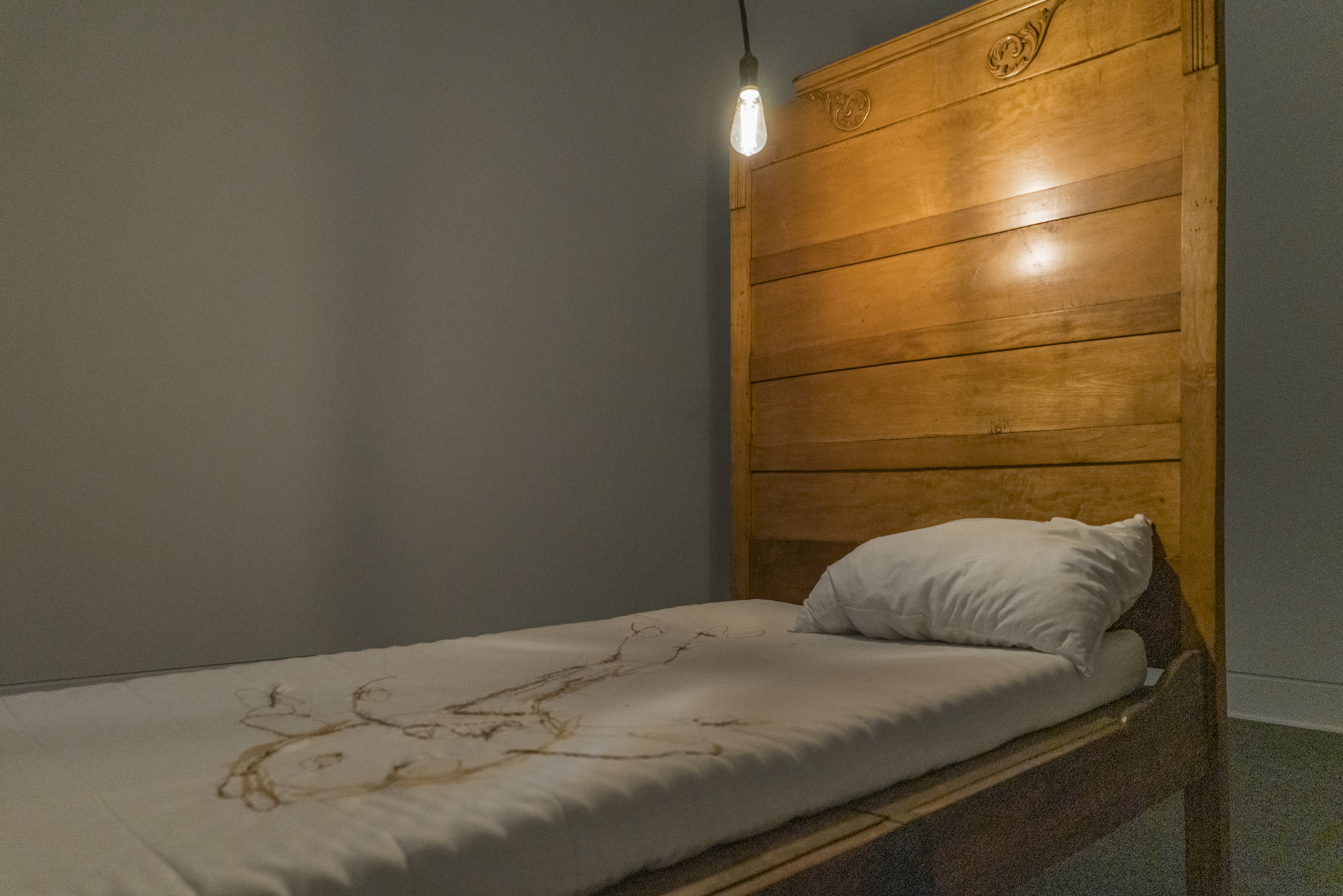“The abuse of a child is the business of anyone who knows about it.”
The Program, directed by Katherine Kubler
“And yet domestic violence is private, existing within someone’s home in isolation and extreme vulnerability.”
IN MEMORY OF exhibition statement, show curator Ionit Behar, Ph.D.
I’ve chosen to use the phrase victim/survivor over survivor below, because in order to call myself a survivor, then I must acknowledge that I was first victimized; that there was something I had to survive. How much is too much corporal punishment? What household objects are “appropriate” with which to hit your kids? How hard are you “allowed” to choke your teenage daughter? How fast can she run from you? If you are “allowed” to hit your kids, then what else are you allowed to do to them?
Domestic violence can be enacted upon an intimate partner, their children, and/or other members of the family or household. However, in states like Indiana, you are legally allowed to hit your children (or other minors under your care) with the defense of “reasonable parental discipline”. This means that physically striking your child can be deemed “appropriate” by law.
This is part of the problem.
When there is no line drawn on how children can be treated, it becomes difficult to say what makes a home safe; essentially, what makes a home, a home.
Physical violence is abuse. For me, using the term victim acknowledges that, yes—I was victimized, yes—it really did happen, and no—it shouldn’t be allowed.
“Domestic violence is neither an unfortunate fate for the unlucky few nor the result of bad choices and cruel environments. It is rather a social ill, an epidemic that crosses geographic, cultural, and linguistic barriers.”
IN MEMORY OF exhibition statement, show curator Ionit Behar, Ph.D.
US Department of Justice
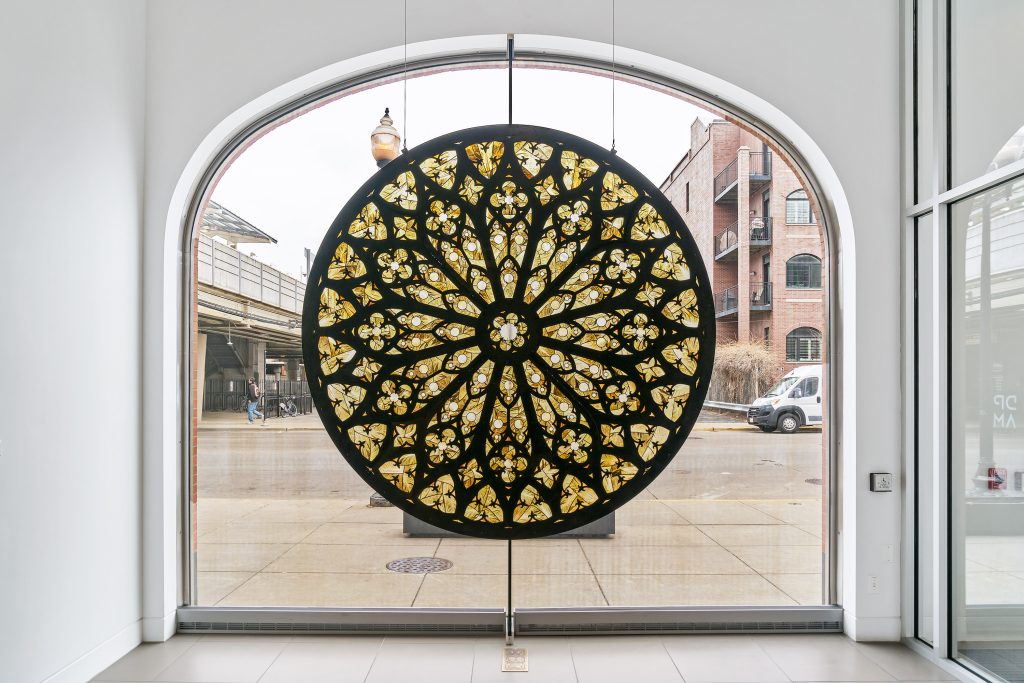
There are powers at play within all institutions, some more dangerous than others. In the home, parental authority can easily morph into abuse. In schools, teachers and coaches enter into abusive relationships with students under the guise of mentorship. Religious organizations are often rife with sexual abuse by those in power. As Jenny Holzer aptly stated, “Abuse of power comes as no surprise.”
Throughout Selva Aparicio’s solo exhibition, In Memory Of, the insidious nature of such power is gorgeously revealed through the artist’s sharp and exacting eye. At the same time, the pains of power are hideously revealed, as her work is presented through the lens of what ought to be an intimate and safe space: the home. The artist opens with a rose window, an architectural element found in Gothic cathedrals, displayed upon a glass wall. Sunlight pours through the glass and illuminates the rose’s patterns of pale green and orange. However, this piece, Remains, is not made out of stained-glass, but discarded lettuce leaves shaped to mimic a stained-glass window. The illusion of Remains, accomplished through Aparicio’s intertwining of form and material, is a direct nod to the Cathedral of Santa Maria del Pi in Barcelona Spain, and according to the exhibition’s text is a nod to the unequal power dynamics often found within religious structures. Right away, the artist alludes to one of the world’s most widespread and powerful institutions—one that, at this point, is almost synonymous with the cover up of abuse.
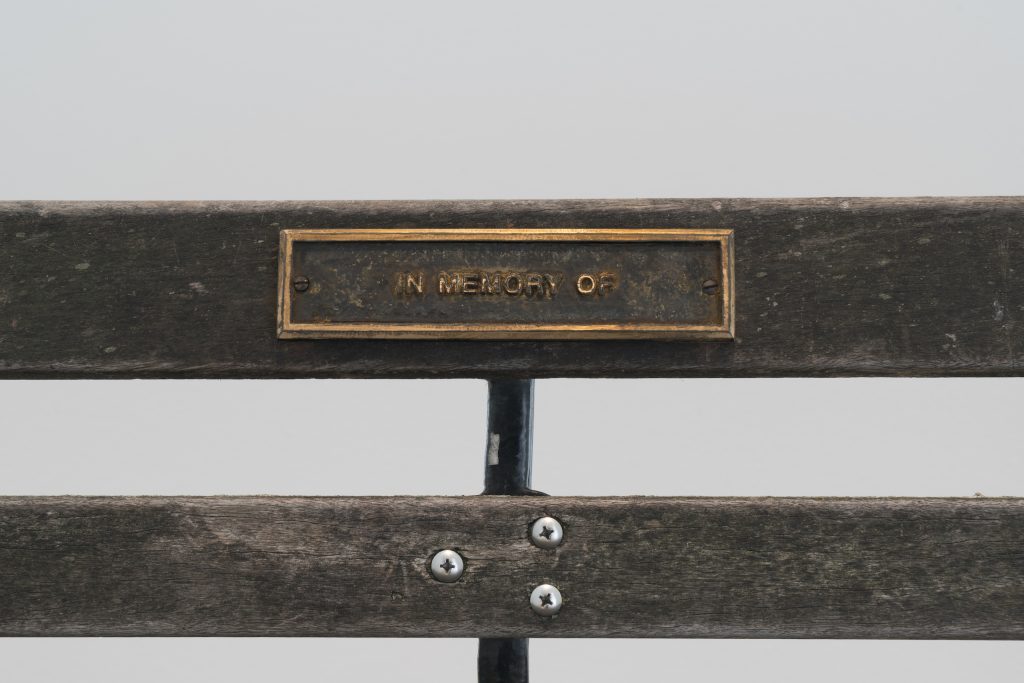
The materials used in Remains are ephemeral (a recurring theme in Aparicio’s work); the lettuce will decay. Like most cathedrals, Remains is ornate, stunning, almost holy as it glows from behind. Yet all things fade. By using ephemeral materials, I read the artist’s intent in two ways: the piece imagines the Catholic church’s decay as well as the hope and possibility to be found at its end. All things crumble. A spark of hope. Authority is never impenetrable.
Step into the exhibition and you enter a small, sparse room. Only a lone bench sits in the space. With a small plaque labeled with the work’s title, In Memory Of, this piece is a memorial bench, one you might find along the beachfront or in a park. Sitting on Aparicio’s bench, you are meant to feel comfortable and safe. The exhibition text even states the piece is a “quiet space to sit and reflect for those grieving or remembering a loved one.” But if this is a memorial bench, then who am I to grieve? For whom do I grieve? On the wall directly in front of you, a square section is cut out to resemble an interior window. Ornate bars cover the window and allow a sitter an obstructed view into a connected gallery space. The window’s title, Saudade, means “a feeling of longing, melancholy.” Although you can see through the window, there is no way to enter through it (or exit, if you are on the other side). There is a longing that can never be fulfilled, you cannot reach the other side. This sense of mourning for what you cannot reach sets the tone for the exhibition.
The presence of the window, this moment of being outside but looking in, the other side being just out of reach, the punctum that sits at the heart of the show.
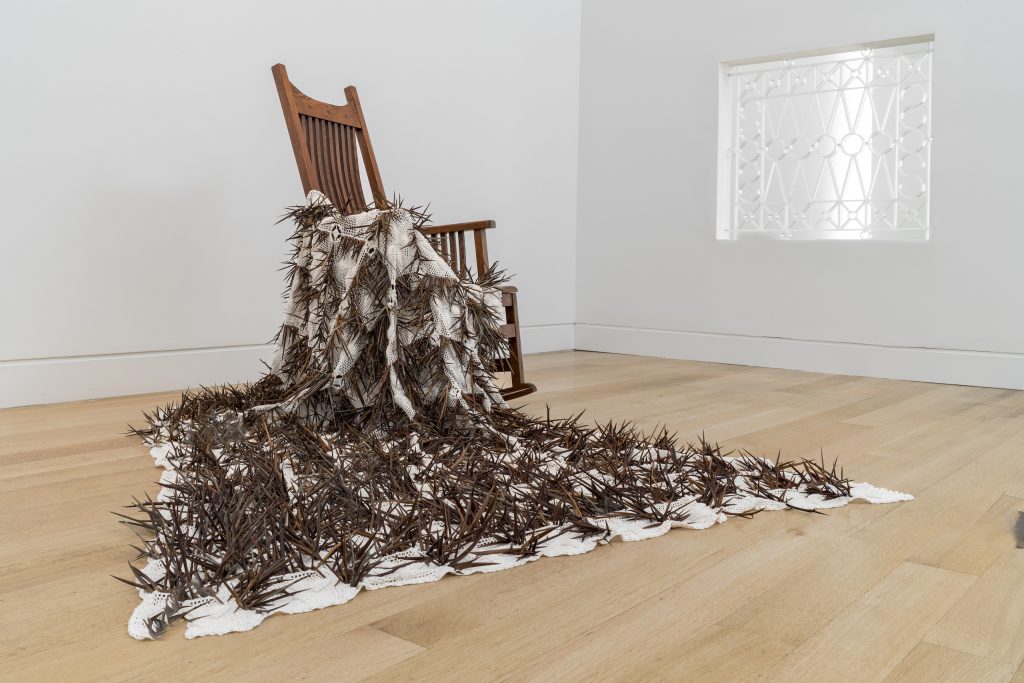
Sitting on the bench, I am immediately faced with a domestic scene on the other side of Saudade: a crocheted blanket draped over a wooden rocking chair. Rocking chairs assuage and comfort, while handmade blankets offer warmth and familial care. However, Aparicio’s rocking chair, Solace, sports a blanket filled with sharp, protruding honey locust thorns. The thorns’ menace, their danger, their looming presence dominates the scene. Like a violent parent, you never stop wanting it to comfort you, to provide protection, but the danger is always present, embedded within their fabric. If you place this blanket on your lap, one wrong move and the thorns will jab you. I grew up in a home where I walked on eggshells and feared that one wrong move.
I mourn for my past self as I sit on that memorial bench.
In this moment, I stand outside. I am an onlooker, a bystander, this is ‘none of my business.’ But to see the rest of Aparicio’s delicate and dangerous objects, I must step inside the home—a place that, growing up, produced such anxiety that I would often have stomach aches as I reentered, always trying to make the right decision. How do I slip in without being noticed? Do I have time to quietly run upstairs or has the shutting door given me away?
Navigating the gallery spaces, Saudade situates the viewer as both inside and outside the home; they become both witness and victim/survivor. Saudade’s bars block your way “out” and “in.” This structure is both physically real and a metaphorical device. Like the “home,” it keeps family members in while also keeping bystanders out. Escape and help just out of reach. The home is also an institutional power, one that we must interrogate and hold accountable. All power must be put in check, as power is so easy to abuse.
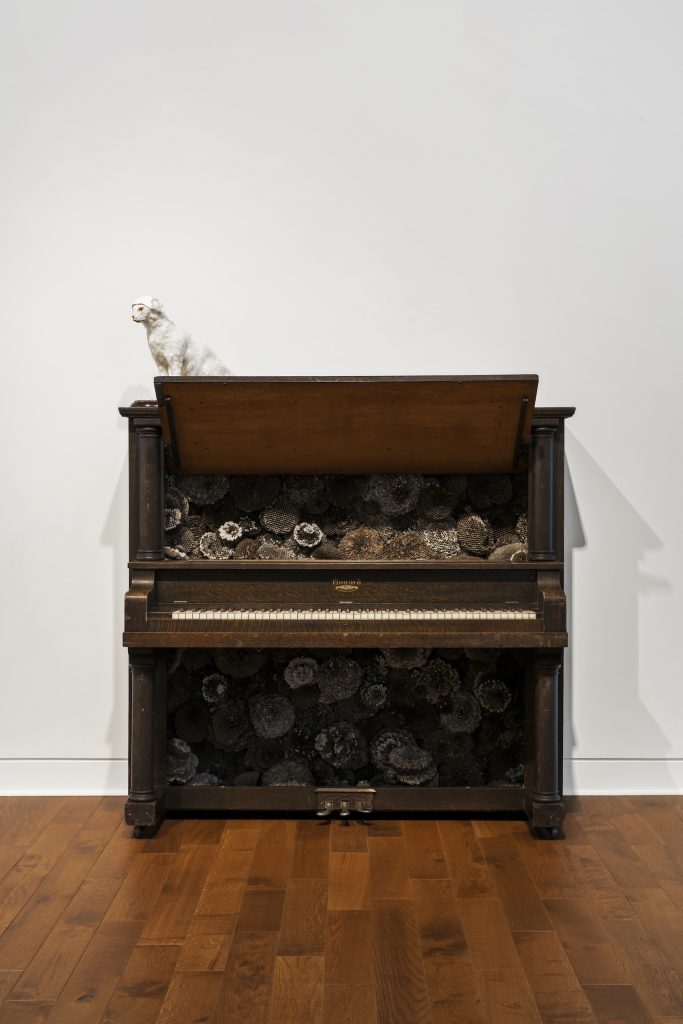
Inside the galleries, Aparicio offers us a rug, a piano, a (taxidermied) cat, a bed; each object contains an element of the surreal. Like Surrealist Meret Oppenheim’s saucer and spoon covered in fur, something visceral, something strange encroaches upon the boundaries of each object. The piano, Time’s Refrain, is ripe with wasp nests which render the instrument unusable. Solace’s thorns subvert the blanket’s comfort. The bed, utterly alone in a room with a menacing flickering light, is not one I would ever lay on. The rug, Childhood Memories, is not soft—instead, it is carved into the floor. For me, this rug functions as a shadow, an endless echo of the original object. Like the rug, memories are also shadows. No matter how you grow, how you heal, there will always be a darkness. A shadow is always behind you. Like a home that is unsafe, one filled with violence, everything is not as it may seem. For those living within this violence, the home is transformed, delicate with danger, filled with eggshells upon which you must carefully tread. The home becomes surreal.
The exhibition’s shifting perspectives, the movement between viewpoints causes a seasickness of oscillating safety. Am I inside the home looking out, or am I outside looking in? This structure cannily and painfully mirrors the experience of domestic violence. You are witness, perpetrator, and victim/survivor. Domestic violence infests families: one can be both witness of and target for violence, it just depends on the day.
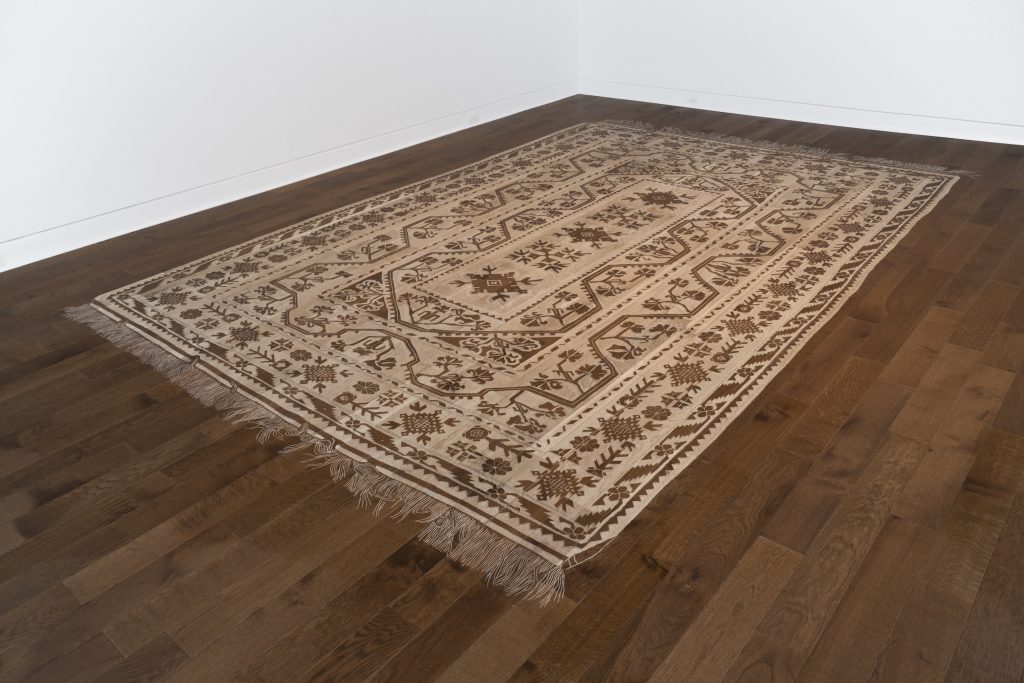
Themes of grief and mourning show up throughout Aparicio’s practice. In the past, she has employed ephemeral, organic materials in her work (often from once-living plants, animals, and insects) to touch on ideas of life and death. She engages these same strategies throughout In Memory Of. The impermanence and fragility of life is on full display through the use of parts from a once-alive whole, such as thorns from a Honey Locust in Solace. However, in the exhibition, there is a shift from an emphasis on life and death to what is left behind, what continues on after mourning, after grief, after survival. In her piece Echoes of Resilience, various clumps of organic matter are hung together in pairs in a grid, displayed on rods coming out from the wall. They are intentionally minimal; the viewer must confront each element of the piece: moss, shells, hair, and more. These objects are beautiful on their own, separated from what they once were when they were alive. There is a shift in power I feel throughout these works: institutional power and authoritative abuse are ephemeral. Power can crumble and deteriorate under the strength of the people. If the insidiousness of these power structures are revealed in In Memory Of, then so is our shared resilience. The victims, the survivors—however changed—are who remain.
We were greeted with the gorgeous, and we ended with the painful: Remains. Aparicio’s gorgeous materials and construction function as the metaphorical cover up, they hide the violence that happens behind closed doors. The gorgeous is also the desire for safety, love, and support. The thorns, wasps nests, and the barred window all represent the ever-present pain of danger. This pain is felt for what was lost, the dull rot of a past that can’t be changed. The physical pain inflicted is equal to the pain later felt from mourning the loss of childhood. There it will always remain.
We begin and end in the same place; a reminder that grief, mourning, and healing are not linear.
Selva Aparicio: In Memory Of is on view at the DePaul Art Museum March 14 through August 4, 2024.
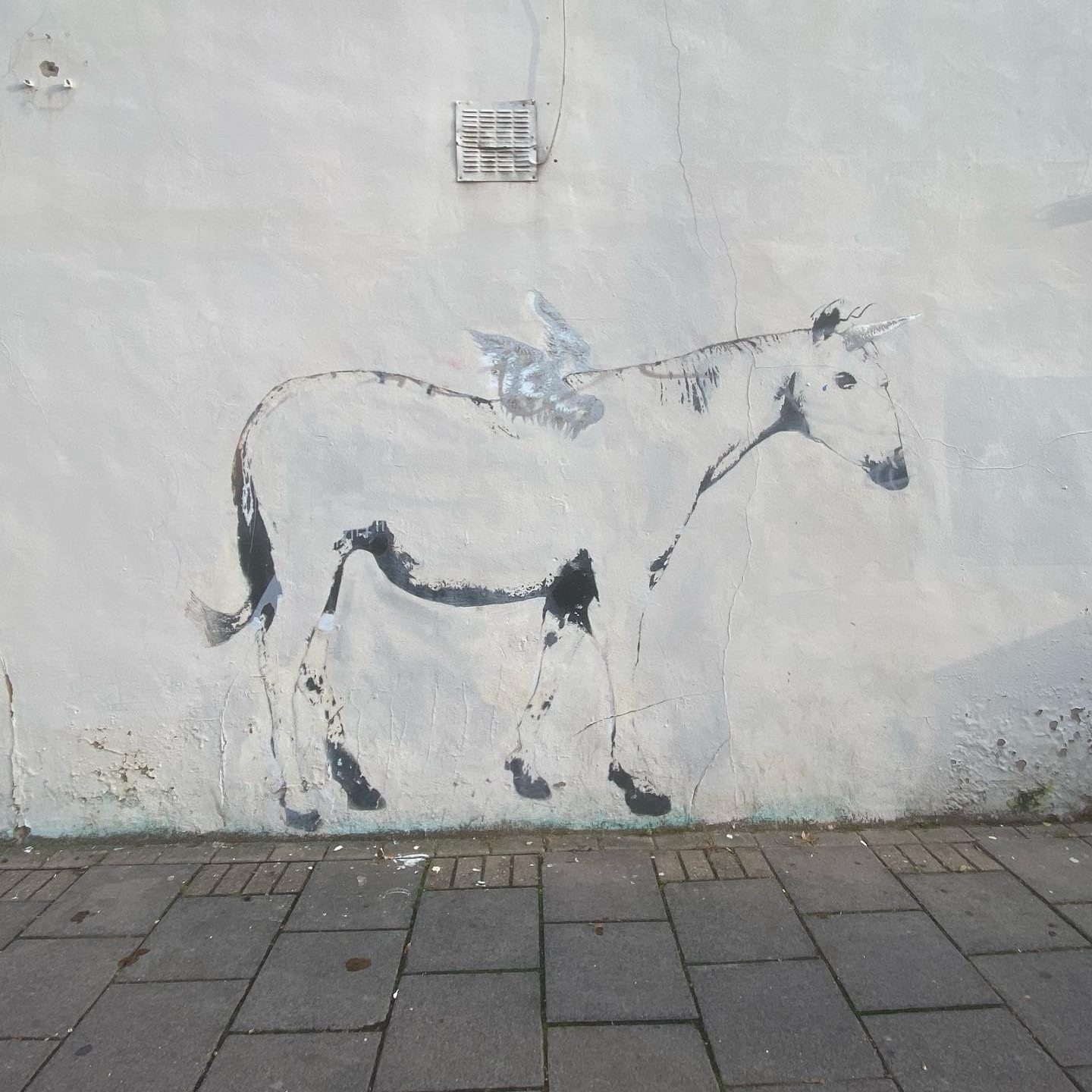
About the author: Kay Ana uses oversharing as a tool to form the world within them and shape what they want others to see. Kay Ana is a little mophead currently surviving on the third planet by way of the family they forged at sixteen.
